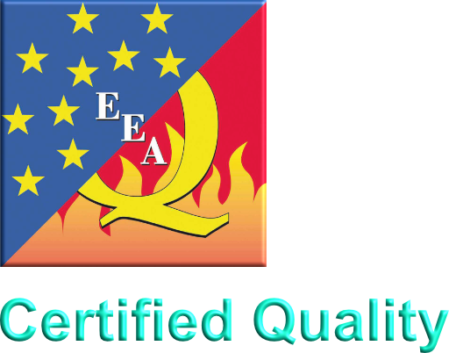
How are the requirements tested?
The procedure for testing is described in detail in Chapter 1 of the Handbook “Quality Requirements”. EEA distinguishes between companies with and without ISO 9000 certification.
EEA accepts companies, which have no ISO 9000 accreditation, but will demand an independent initial audit by an auditor or team accepted by the EEA Technical Committee. If EEA decides to authorize the certification, then the company will be entitled to use EEA Quality Mark for the products concerned for a period of maximum three years. The company will pay an initial registration fee and an annual fee to EEA for the license to use the Quality Mark. Once a year an independent inspection committee, accepted by EEA, will carry out an audit on one or more areas of application of the company. The initial audit team will perform the audit according to the method described in EEA’s Manual. At an audit, the company should be able to submit the necessary test results; show who is responsible for the tests and what measures are taken if the quality requirements are not met. Test result should be submitted for each application for which the company wants to receive a license.
The Quality Assessor(s) will submit the test report, with their recommendations, to EEA. A copy of the audit report will be sent to the Executive and Technical Committees of the EEA. These Committees shall express their decision within two months.
A company with an ISO 9000 accreditation wishing to obtain accreditation for use of EEA’s Quality Mark will be required to give details and qualified assurances to the Technical Committee of the EEA to show that they will meet the quality requirements determined by EEA. This will be accomplished by submission of all relevant documents of accredited or certified quality systems in accordance with an ISO 9000 standard, whereby such accreditation or certificate is issued by a certification organization recognized by the Technical Committee. Further documentation will be required to this certification organization, which will have to send a declaration to the Technical Committee of EEA, stating that the company meets the requirements of the Quality Mark.
In short: the company has to demonstrate to EEA that it has a Quality Management System that fulfills EEA’s standards for the products for which the EEA’s Quality Mark has been requested. Similar further procedures are required in the case of a company without ISO accreditation.
Advantages
A company entitled to use the EEA Quality Mark has demonstrated that it fulfills the quality requirements for the enamel coating of the product it manufactures. The certifying organization has concluded that the company is able to produce according to EEA standards. Of course, the organization or EEA cannot be held responsible if a certain item of the product fails to fulfill the requirements. This is still the responsibility of the producer. If a customer suffers damage because of a defect of an enamelled product and the damage is due to the poor quality of the enamel, the enamelling company itself will be in charge of properly settling the damage . What is the advantage for the customer then? The customer can point to the fact that the producer displays the EEA’s Quality Mark, which guarantees conformity according to EEA’s quality standards, while the enamel is of poor quality and the enamelling company will be found liable for the damage. Also, the company may very well loose its license at the next audit.
